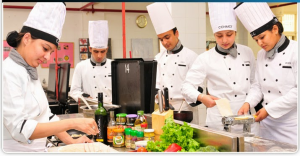FOOD PRODUCTION NOTES
4. TOPIC TWO- KITCHEN STAFF
KITCHEN STAFF
ORGANISATION CHART OF LARGE HOTELS.
HEAD CHEF
Second chef
CHEF DE PARTIE
ASSISTANT COOKS
APPRENTICE
Organization chart of industrial catering kitchen.
CHEF
PASTRY CHEF LARDER MAIN DISHES SOUP VEGETABLES
APPRENTICE GENERAL ASSSISTANTS GENERAL ASSISTANTS
Organization chart of schools /college
Senior cateress
Assistant cateress
Head cook
Assistant head cook
Assistant cooks
Kitchen cleaner.
Organization chart of a typical food production department
Executive chef/head chef
Pastry chef banquet chef assistant chef
Pastry cooks banquet cooks cooks stewards
QUALIFICATION /CHARECTERISTICS OF A SUPERVISOR /HEAD CHEF OR CATERESS.
· He must be lively and ability to direct every employee in their jobs.
· They should pose a complete knowledge and experience in the job.
· Should have good health.
· Should be patient to cope with every situation.
· Should have a pleasant personality and ability to converse with or types of people.
· Should have the capacity to meet the emergencies and to solve them quickly.
· Should be strict regarding punctuality and keeping necessary rules.
· Should have adaptability and willingness to experiment the ideas.
· Should be able to initiate actions and take responsibility.
· Should be able to enforce discipline to the staff.
· Should be of good temper.
1. DUTIES OF A SUPERVISOR /CATERESS/HEADCHEF.
· Administrator of the department.
· Hire and firing of staff.
· Compiles the menu.
· Orders food stuff, receive and stores appropriately.
· Organize the kitchen to ensure good work always.
· To supervise the kitchen particularly during preparation, cooking and service.
· To advice on purchase of equipment.
· To be responsible for the stores.
· To train and direct staff.
· Maintain good relationship with his or her staff.
Summary
A supervisor –plans the menu the no.of staffs required
-plans for training.
-she organizes the skills to be applied to food production and
Equipment needed.
-Organizes the staff –she ensures that whatever wanted are
Where they are required when it is wanted in the right time.
-directing =where she has commanding skills to give
Instructions to the staff on how, what, when and where.
-To coordinate –she has to have skills required to ensure staff
Cooperate and work together.
-to control=to control the staff and production and ensure
there is no pilferage
2. DUTIES OF SECOND CHEF (LE SOUS CHEF)
-Relieves the head chef when he is off duty.
-supervises the work in the kitchen so that it runs smoothly.
-responsible for banquets.
In large kitchen there can be several le sous chef
3. DUTIES OF CHEF DE PARTIE
-in charge of section of work in the kitchen
-organizes their sections.
-delegate work to the assistance.
4. DUTIES OF ASSISSTANT COOKS (LES COMMIS CHEF)
-To assist the chef de partie
The no.vary with the amount of work done by the party e.g. vegetable party
Is large than the fish party.
5. APPERENTICE
He/she is learning the trade and is moved to each of the parties to gain knowledge of all the section in the kitchen.
6. SAUCIER
· Cooks all the meat ,poultry and game dishes which are not roasted
Or sautéed.
· Prepare garnish
· Makes all sauces
7. ROATSIER
· Cooks all roasted meat, poultry and game
· Grill and deep fry fish and other deep fried foods e.g. potatoes
· Prepares garnishes for grills and roasts.
· Grills the mushrooms and tomatoes.
· Makes roasts and gravy.
8. KITCHEN LARDER
· Prepares foods cooked by other parties e.g. preparation of poultry
And game fish.
· Prepares cold soups, eggs, fish, meat, poultry, and game.
· Prepares cold sauces and sandwiches
9. KITCHEN STEWARDS
· He empties the bins from the kitchen
· Cleaning the bins
· Cleaning all the bins and pots,pans.
· Keeps the floor clean
INFLUENCE FACTORS ON KITCHEN DESIGN.
1. The size and extent of the menu.
Before a kitchen is planned the management must know its goals and objectives in relation to market strategy.
The menu will determine the type of equipment you will require in order to produce the products that you know from the market research the customer is going to buy.
You need to know the target numbers you intend to service.
2. Services
The designer must know where the services are located and how efficient use can be made of them.
3. Labor and skill level.
What kind of people does the company intend to employ .this will have an effect on the technology and equipment to be installed .the more prepared food used the more this will affect the overall kitchen design.
4. Amount of capital expenditure
Space is at a premium kitchens are generally becoming smaller where finance is often determine the overall design and acceptability.
Equipment is therefore being designed to cater for this trend becoming more modular and streamlined and generally able to fit into less space .which is seen as cost –reduction exercise
Labour is a significant cost factor so equipment is being designed for ease of operation, maintenance and cleaning.
5. Types of equipment available
When planning a kitchen standard symbols are used that can be produced on squared paper to provide a scale design type amount and size of the equipment will depend on the type of menu being produced.
6. Hygiene and the food safety act 1990/91/95
The basic layout and construction should enable adequate space to be provided in all food handling and associated areas for equipment as well as working practices and frequent cleaning to be carried out.
7. Government policy.
